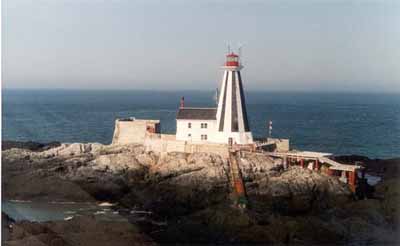Light Tower
Recognized Federal Heritage Building
Gannet Rock, New Brunswick

Exterior photo
© Transport Canada, 1990
Address :
Grand Manan Island, Gannet Rock, New Brunswick
Recognition Statute:
Treasury Board Policy on Management of Real Property
Designation Date:
1991-11-01
Dates:
-
1831 to 1831
(Construction)
Other Name(s):
-
Gannet Rock Light Tower
(Other Name)
Custodian:
Fisheries and Oceans Canada
FHBRO Report Reference:
90-112
DFRP Number:
81596 00
Description of Historic Place
Gannet Rock Lighthouse is located on the isolated, small, barren island off Grand Manan in the Bay of Fundy. It is distinguished by its tapered, octagonal, wooden construction, by its shingled exterior and by its concrete base. A gallery and metal lantern surmount the flared top of the shaft. A two-storey concrete dwelling adjoins the tower at its base. The designation is confined to the footprint of the building.
Heritage Value
Gannet Rock Lighthouse is a Recognized Federal Heritage Building because of its historical associations, and its architectural and environmental values.
Historical Value:
Gannet Rock Lighthouse is one of the best examples of a structure associated with the provision of navigational aids for international and commercial traffic navigating the entrance to the Bay of Fundy. Gannet Rock is considered the most isolated light station on the Fundy coast. The Lighthouse is the second-oldest wooden tower within Canada.
Architectural Value:
Gannet Rock Lighthouse’s designer was the prominent New Brunswick architect John Cunningham. The functional tower consists of heavy hewn-timber, the top six metres being built of heavy sawn construction, all done in a manner typical of the era.
Environmental Value:
Gannet Rock Lighthouse establishes the present picturesque, maritime character of Grand Manan Island and establishes the Bay of Fundy as an important region for shipping. The Lighthouse is well-known to the shipping community and is a regional landmark. It is considered to be a long-standing symbol of the maritime heritage of the region.
Sources:
Gordon Fulton, Lighttower, Gannet Rock, New Brunswick, Federal Heritage Buildings Review Office Report 90-112
Gannet Rock Lighthouse, Grand Manan Island, New Brunswick, Heritage Character Statement 90-112
Character-Defining Elements
The following character-defining elements of Gannet Rock Lighthouse should be respected, for example:
Its functional design and good quality materials and craftsmanship, for example:
The building’s form and massing, consisting of an octagonal design, tall profile, and platform surmounted by an iron lantern. The windows located in the shaft of the structure. The building’s limited decorative detailing. The shingled exterior and the concrete base. The vertical black and white stripes which accentuate the tower’s height.
The manner in which the lighthouse establishes the picturesque, maritime setting of Grand Manan Island, and acts as a regional landmark as evidenced by:
The structure’s location in its environment, attached to the two-storey dwelling where the structures seem to rise from the bedrock of the exposed, small island setting. The Lighthouse’s high visibility as a local landmark.
Heritage Character Statement
Disclaimer -
The heritage character statement was developed by FHBRO to explain the reasons for the designation of a federal heritage building and what it is about the building that makes it significant (the heritage character). It is a key reference document for anyone involved in planning interventions to federal heritage buildings and is used by FHBRO in their review of interventions.
The Gannet Rock light tower was built in 1831. The designer of the Gannet Rock light tower was the prominent New Brunswick architect John Cunningham, who also surveyed the Gannet Rock site in 1831 and designed a protective stone wall to surround the base of the Gannet Rock tower in 1842. In 1905 a new concrete base and a new gallery were added. The owner of the property is Transport Canada, Canadian Coast Guard. See FHBRO Building Report 90-112.
Reasons for Designation
The Gannet Rock light tower was designated Recognized because of its historical association, its aesthetic value and its environmental value.
The Gannet Rock light tower serves regional and international commercial traffic navigating the entrance to the Bay of Fundy. Gannet Rock is considered the most isolated light station on the Fundy coast. The light tower is the second-oldest wooden tower extant in Canada. Gannet Rock light is very well known both on and off Grand Manan Island, and is considered a long-standing symbol of the maritime heritage of the region.
Character Defining Elements
The heritage character resides in the form, proportions, construction and materials of the tower and in the relationship of the tower to the site and to the adjoining dwelling.
The light tower consists of a tapered, octagonal heavy hewn-timber construction (the top six meters is built of heavy sawn timber) with a shingled exterior. The wooden structure rests on a stone foundation capped with concrete. The tower's form, proportions and materials should be carefully preserved.
The vertical black-and-white stripes (a paint scheme utilized since at least 1857) accentuates the tower's height. When repainting, this colour scheme should be maintained. Reinstatement of the windows with their decorative pediments which were removed would greatly enhance the aesthetic qualities of the tower.
The form and proportions of the adjoining 1931 two-storey concrete dwelling are compatible with the character of the tower. Any new building should respect the scale, materials and colour of the existing structures and should not mar the profile of the prominent light tower.
The light tower, dwelling, walls and platforms sit on a small rocky barren island. The structures seem to rise from the bedrock. This relationship of the structures to the site should be maintained.